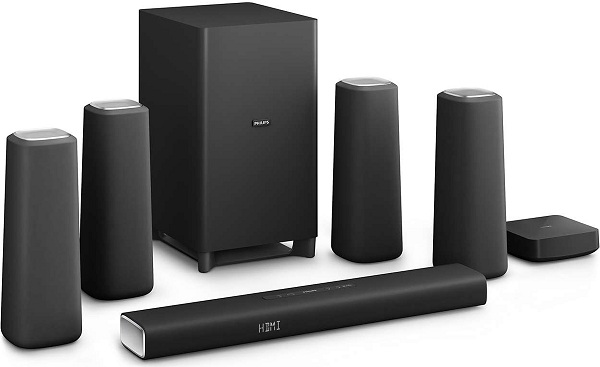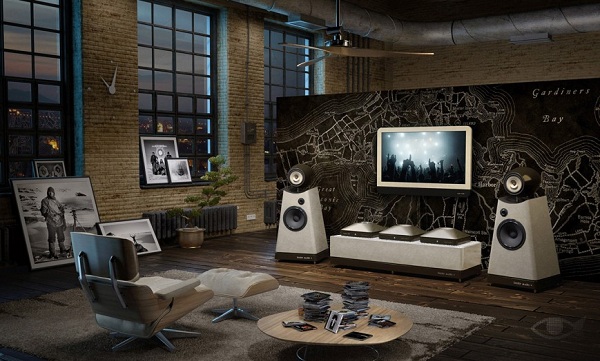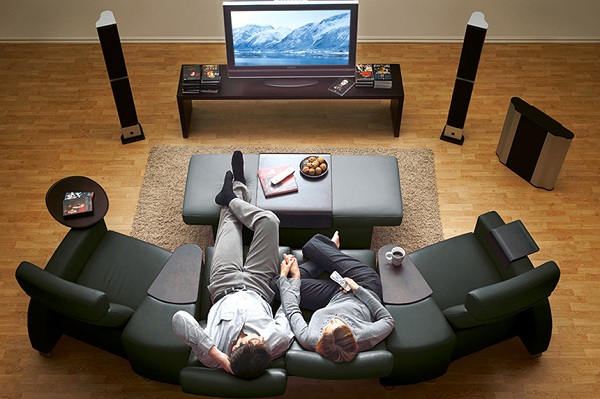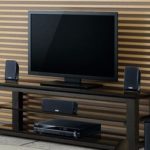Features home theaters with wireless speakers
A few decades ago, no one could have imagined that acoustic speakers can work on their own, without a power cable, and the equipment can be easily moved around the room. Eternally entangled cables always annoyed home theater owners with an abundance of dust, interfered with normal walking around the room, often corny their domestic cat. With the advent of wireless acoustics, this problem becomes resolved.

Classification of acoustics
Home theater acoustics will always be a problematic issue that requires a careful and balanced approach. After all, only by location acoustic systems can be divided into several types:
- floor standing;
- ceiling;
- built in;
- wall mounted;
- shelf.
Categorize home theaters according to the signal transmission method much simpler, they are divided into:
- wired;
- wireless.
Cinemas that use wired connections are distinguished by their set of drawbacks: floor speakers require space and proper placement from an interior point of view. Built-in speaker system solves all the problems of placement, but does not give an answer to the question: where should we put this terrible harness from the supply wires? The situation with wall acoustics is even worse, cords either disfigure walls when external laying or repair is necessary for laying special channels.
It would seem that the wireless acoustics system will eliminate all these flaws, but they also have a lot of underwater obstacles that we will try to figure out.

Ceiling speakers
Feasibility of wireless acoustics
A wireless home cinema can be recommended if:
- for a long time, the apartment is not planned to overhaul, but there is a necessary number of feeding outlets, with which you can optimally arrange the components of the speaker system;
- there is a desire to preserve the attractiveness of the already created interior;
- A “cool” acoustics system with a large range of speakers, wall-mounted speakers and two subwoofers is considered.
It should be noted that the use of a wireless speaker system does not exclude the presence of complete floor and ceiling speakers.
But there are a number of conditions under which the use of wireless speakers is not desirable:
- If the apartment is another source high frequency radiation, his work will affect the level and quality of sound. A router or a microwave oven, even in the next room, can interfere.
- If the apartment is not possible to create conditions for the high-quality distribution of the sound signal. In other words, there is no way to implement home theater in a separate room without furniture.
The financial factor is important: the implementation of the idea of high-quality home cinema with full wireless acoustics is a very expensive pleasure, an order of magnitude higher than embedded and wall-mounted systems. But the quality of the image and the ambient sound fully correspond to the costs.
With a sense of reality, you need to approach the assessment premiseswhere the wireless acoustics system will be located. Its multi-component nature automatically requires a lot of space. For small rooms, either wall-mounted or built-in ceiling acoustics are more suitable.
It is advisable to give preference to companies that have a good reputation and considerable experience in designing such equipment. One of the leaders in this format is recognized by Sony (Sony). A good panoramic sound of its acoustics systems is provided by the rear satellite operating over the radio channel. In all its columns there is a set midrange speakersthat gives the sound a unique presence effect.
Home theaters with ceiling acoustics. If the built-in or wall acoustics have a special design, the bookshelf consists of columns of standard form, and is installed on any elevations. The advantages of such devices are obvious: installing columns you can take into account all the features of the interior.
Given all the above subtleties, we conclude that wireless home theaters it is reasonable to buy if:
- there is an irresistible thirst for creating an enhanced acoustic effect;
- in the fulfillment of this desire, all conditions (technical prerequisites and the necessary premises) are met;
- I really do not want to stick in the clumps of wires;
- financial burden does not matter;
- Work skills require high sound quality.
In all other cases, you can stay on an embedded or wall-mounted system that will be able to please the average consumer with good sound quality.

Some technical details
The normative requirement for creating a qualitative presence effect is the ratio of 5.1 sound channels (5 acoustic speakers and one subwoofer). This is the minimum required for the initial stage of building a home theater.
But there are more sophisticated systems (7.1 and 9.2), the main prerogative of which is the synthesis of almost perfect sound. If such a professional need arises, the wireless acoustics system for home cinema is the surest solution: connecting so many components with the help of wires causes great difficulties.
It is necessary to have a lot of sockets, since the speakers work on batteries or accumulators for a very short time.
And one more problem: in standard wireless home cinema real wireless is usually both rear speakers. The rest are either wall mounted or recessed or floor mounted. The longest part of the cable leads to the rear speakers, so they are very difficult to hide. It should be noted that in the rear speakers, in addition to the sound signal itself, there are also control commands - volume control, delay coefficient to maintain the volume effect.

The level and characteristics of the audio signal of wireless speakers are not similar to the level of wall-mounted and embedded systems. If you refuse the connecting wires, then the speakers of the audio system must be placed analog amplifier, and quite high class. Such an acoustic column is called active, and the probability of introducing its distortions into the common signal is high. Plus the presence of an amplifier in each column significantly increases the cost of the system. The issue of heat transfer is no less relevant. Designing a wireless speaker that would have parameters close to embedded systems, but would be passive - is not yet possible.
The ratio of sound quality and physical dimensions of the speaker remains the same - the more, the better, and here the wireless speakers lose to their outdoor counterparts.
About 50% of the maximum enjoyment of the sound system is based on the location of the speakers - relative to each other and users. And only wireless speakers allow you to achieve the optimal location, and hence the sound.

/rating_off.png)












